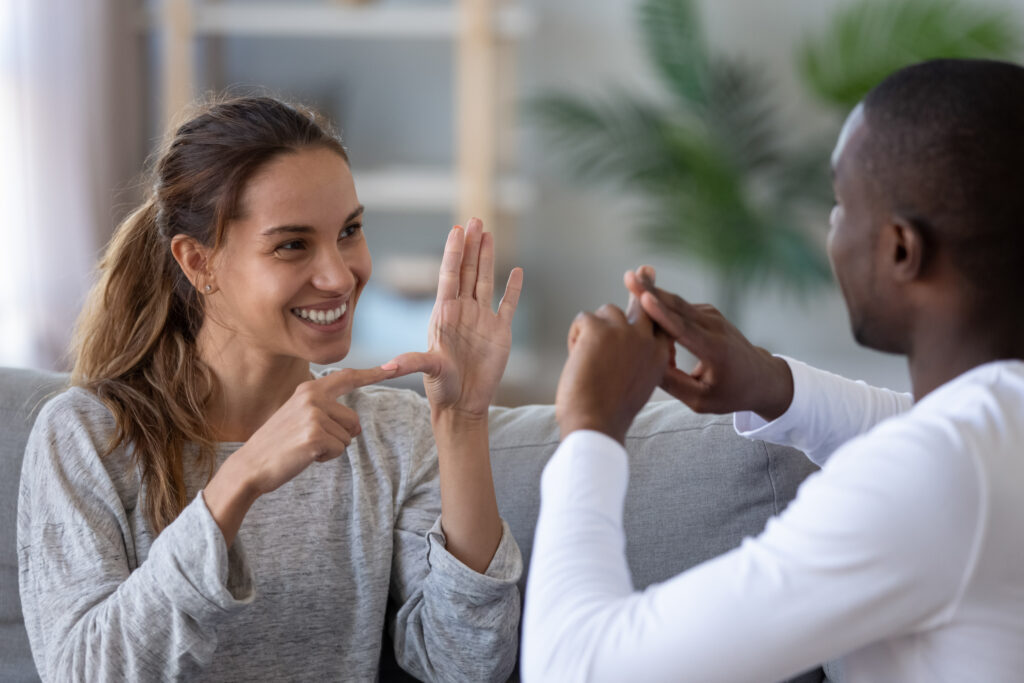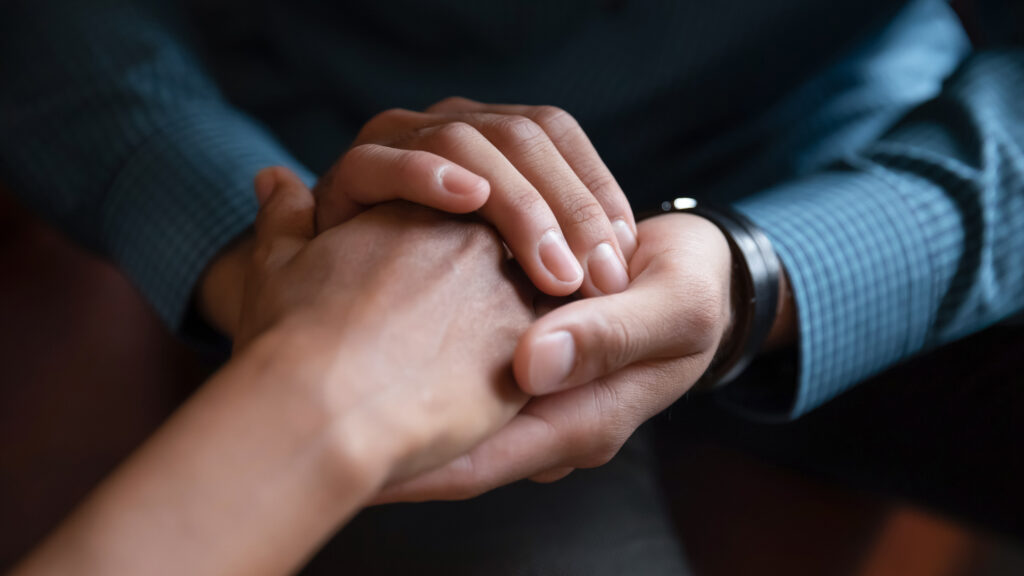
Every day we communicate with our fellow human beings. We make small talk, exchange experiences and share our everyday life with each other. Even when we're not talking, we're communicating. How do we do that? In this article, you'll learn more about the types of communication.
Communication means nothing more than the exchange of information between different people. This can take place in very different ways. You're probably thinking of the typical conversation or texting, and you're absolutely right! But these are by far not the only ways you can exchange information with your fellow human beings.
Basically, all your senses are involved here. In every way in which you can perceive something, you can also receive information. From this, four basic modes of communication have emerged that have become an integral part of linguistics:
But what exactly do we need all this for? Man has been anxious to form communities since time immemorial. Being together gave him protection, because in a group one is known to be stronger than alone. Especially in times of great danger, such as saber-toothed tigers and other predators, man had a very hard time surviving alone. This is exactly why living in company has been in our genes since time immemorial and will probably always remain so.
But life in a group can only be successful if everyone gets along well with each other. And what is the cause of most conflicts? Exactly, faulty or even lacking communication. And that's why it's so important that you are aware of how many ways you actually disclose information, sometimes even unintentionally.

From an open and honest word to one of your fellow human beings to a mere frown - it's all communication. Even changing your tone of voice says an incredible amount, even if your words actually say something else. But let's not beat around the bush. Let's finally address the four types of communication in concrete terms!
Verbal communication is nothing other than speaking. This makes it the most important form of communication. What matters here is the exact words we use. But they convey not only information about content, but also about how you relate to your communication partner. If you are talking to someone who is superior to you, such as your boss or your department head, you probably choose more formal words.
When you talk to your friends, on the other hand, you can be a little more relaxed in your choice of words. Here you tend to pay less attention to which expressions you use. The same applies to dialects. If you decide on a formal way of verbal communication or talk to someone who comes from another region, you will certainly speak primarily High German. If, on the other hand, you are traveling with friends or people from your region, you are less likely to shy away from speaking in dialect.
But as already mentioned, verbal communication is not just about the pure content you convey. After all, as the saying goes, "The tone makes the music!" So it also depends on how you speak. First and foremost, this includes your tone of voice. It determines whether the person you are talking to really understands what you have said in the way you meant it.
With your tone of voice, for example, you communicate whether you are angry or merely making a pure statement without judgment. You also show whether you are sad, frustrated, happy or even exuberant, or whether you mean something ironic. At the same time, your tone of voice conveys how you feel about the other person. Do you choose your respectful or trusting tone or perhaps even speak down?
The pitch and volume of your voice are not entirely uninvolved. If you are happy or excited, your voice rises. If, on the other hand, you are angry, you will be loud. If, on the other hand, you are anxious or uncomfortable, you tend to speak more softly.
You've probably already guessed: nonverbal communication is the exact opposite of verbal communication. In other words, you convey information without speaking. This happens both intentionally and unintentionally. For example, if you give your friends a knowing look because you can guess exactly what they're about to tell you, you're doing it on purpose. If, on the other hand, you suddenly look startled because someone informs you of something you didn't expect at all, this is completely unintentional. In both cases, however, you have communicated nonverbally.
Most of the time, however, this type of communication is actually unintentional. Nobody has his facial expressions permanently 100 % under control and that is also good! After all, it complicates communication immensely if a large component of it is completely prevented.
If facial expressions, gestures and the like are completely ignored, misunderstandings can arise very quickly. Most often, it is then not quite clear how seriously something is meant or whether it was perhaps intended as a joke. As a rule, you mark this difference not with words, but with your facial expression. If it is cheerful and teasing while you are saying something, your counterpart knows that you don't mean it and just wanted to make fun. If, on the other hand, your look is serious, it quickly becomes clear that there is no trace of irony.
Even your posture says an incredible amount. For example, if you turn slightly away from the person you're talking to and fold your arms, you're expressing reluctance. If you stand slightly crouched and hardly dare to look your counterpart in the eyes, this shows that you are Uncertainty. If, on the other hand, you stand up straight and with an open body posture, this shows closeness, but also Self-confidence.
Gentle touch can reveal just as much information. A gentle stroke of the arm can be soothing and encouraging. A firm handshake shows strength and self-confidence. If, on the other hand, you fidget all the time and can't keep your hands still, the person you're talking to knows exactly that you're upset.

Written communication has evolved enormously over the centuries. It used to be the preserve of scholars, Read and learning to write. Accordingly, they were also the only ones to keep books and send letters. Fortunately, all children now learn to read and write. Sending letters, however, has declined sharply. Instead, we send several dozen text messages every day, something no one would have dared to dream of a few decades ago. But no matter in which form we send texts, we always convey information or at least the desire for it.
This is how we keep in touch with family and friends, contact customers and business partners, or create teaching materials for educational institutions of various kinds. However, written communication is predestined for misunderstandings. Since you can't see your conversation partner, you miss all the signs of nonverbal communication. Facial expressions like an amused wink or tone of voice like a deep serious voice are completely absent. So you can only hope that your counterpart interprets what you have written correctly. In case of doubt, an additional phone call helps to clear up any ambiguities.
To ensure that information can also be conveyed well in written form, it is helpful to design it clearly. Paragraphs and line breaks are particularly useful for longer texts to make reading easier. The use of grammar and spelling rules is also indispensable for comprehension.
Of course, when writing short text messages, we tend to disregard these rules. That's not a bad thing at all, as long as it doesn't have a negative effect on reading comprehension. It is also questionable whether the addressee might not be annoyed by the neglect of the rules. For example, if you're writing a business email, it will seem unprofessional if you completely disregard grammar and spelling. If, on the other hand, you are sending a short message to a close friend, he or she will not take offense if you forget a comma and will not immediately question your professionalism.
It is therefore important that you first think about who you are actually addressing in writing. If in doubt, you should refrain from too casual expressions and a too relaxed approach to the rules of grammar and spelling. The top priority is clearly to get your message across clearly and unambiguously.
At the latest when the age of social media dawned, visual communication gained enormously in importance. YouTube, Instagram, TikTok and Co. have raised it to a whole new level. You guessed it, this is all about anything that can be viewed. So you convey information with the help of visuals or videos.
Especially in the area of social media, it's important that you stand out from the crowd. With millions of users, that's not so easy, because the platforms are literally overcrowded. If you want to be successful here, then you can't avoid having a Strategy to develop.
Visual communication can also be wonderfully combined with other types of communication, such as written communication. You can use images and videos to lighten up your texts and make things even easier to understand. This is particularly useful for complex topics. But always ask yourself whether they actually fit the topic and support the message or perhaps even cause confusion. What message do they convey?
By the way, even emojis fall under visual communication. You can use them to add a personal touch to text messages. At the same time, you succeed with them, emotions better to show and mark when you mean something jokingly.
The best communication method is the one that leaves the fewest questions unanswered. Ideally, you should be able to combine several types of communication. Face-to-face information transfer is the best way to begin with, because it includes both verbal and nonverbal communication methods.
To ensure that the people you talk to can still use the valuable information later on, you should ideally even give them the opportunity to look at it again in written form. At best, you can also provide them with the information in text or video form.
Communication always takes place, no matter what we say or don't say. So it never hurts to get to grips with the different types of communication and to improve your own skills in this respect. What is the best way to do this? With a Communication training!

